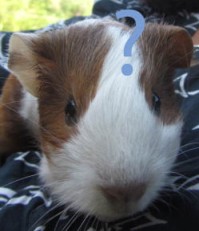![]() Sometimes genetics is like a world-class whodunnit. Imagine: Uncle Donald, a millionaire with an attitude, is found dead in the library, having bled to death from a gunshot wound. The murder weapon is quickly identified as the army revolver belonging to Sir James, the master of the manor, who also had a motive, as he will be inheriting Uncle Donalds fortune. He is arrested and sent to jail, but over the years uncertainty about his conviction grows: a murder just doesn’t fit his profile (he quit the army because he couldn’t stand blood). Then, two years later, a new inspector comes to town: she is convinced that modern methods in forensics can shed new light on the case. Indeed, it does not take long until she discovers fragments of skin from the neighbour, Madame Guillotine, on the weapon, and, in addition, uncovers that Madame was actually a master target shooter in her youth.
Sometimes genetics is like a world-class whodunnit. Imagine: Uncle Donald, a millionaire with an attitude, is found dead in the library, having bled to death from a gunshot wound. The murder weapon is quickly identified as the army revolver belonging to Sir James, the master of the manor, who also had a motive, as he will be inheriting Uncle Donalds fortune. He is arrested and sent to jail, but over the years uncertainty about his conviction grows: a murder just doesn’t fit his profile (he quit the army because he couldn’t stand blood). Then, two years later, a new inspector comes to town: she is convinced that modern methods in forensics can shed new light on the case. Indeed, it does not take long until she discovers fragments of skin from the neighbour, Madame Guillotine, on the weapon, and, in addition, uncovers that Madame was actually a master target shooter in her youth.

Uncle Donald is found dead in the library. Whodunnit…? Picture (It’s Murder, Watson!) by Alan via CC BY-NC-SA 2.0 licence.
Noone is surprised, Madame is known for her vicious temper and had a violent argument with Uncle Donald on the evening of his demise. There is no direct evidence for her guilt, but enough circumstantial data to sway any jury. Then a new witness comes forward: Dr Robinson, an arctic explorer, has just returned from a lengthy mission, where she was studying polar bears, cut off from the world, unaware of the drama unfolding in her home town. She tells the police that she saw someone pour anti-coagulant into Uncle Donalds wine on the evening of her leaving party in the manor. The culprit was neither Sir James nor Madame Guillotine, but Robert, the gardeners adopted son, who is really Uncle Donalds illegitimate child. Robert has a prior conviction for pushing his former girlfriend down the stairs – so a domestic accident, with Uncle Donald bleeding to death would fit his MO. Sounds complicated? Well, in the molecular genetics world, this is more less what has been happening to the FTO locus. Continue reading

